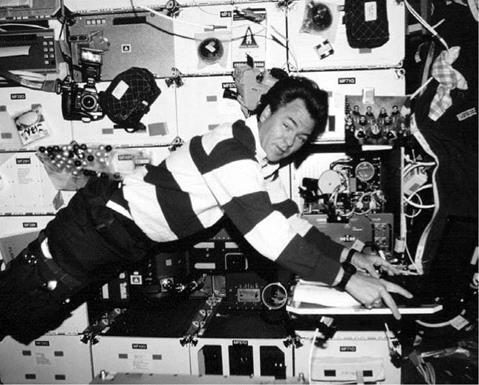STS-85
 1997-039A 7 August 1997
1997-039A 7 August 1997
Pad 39A, Kennedy Space Center, Florida 19 August 1997
Runway 33, Shuttle Landing Facility, KSC, Florida
OV-103 Discovery/ET-87/SRB BI-089/SSME #1 2041;
#2 2039; #3 2042
11 days 20hrs 26 min 59 sec
Discovery
CRISTA-SPAS-02 operations
Flight Crew
BROWN Jr., Curtis Lee, 41, USAF, commander, 4th mission Previous missions: STS-47 (1992); STS-66 (1994); STS-77 (1996)
ROMINGER, Kent Vernon, 41, USN, pilot, 3rd mission Previous missions: STS-73 (1995); STS-80 (1996)
DAVIS, Jan, 43, civilian, mission specialist 1, payload commander, 3rd mission Previous missions: STS-47 (1992); STS-60 (1994)
CURBEAM Jr., Robert Lee, 35, USN, mission specialist 2 ROBINSON, Stephen Kern, 41, civilian, mission specialist 3 TRYGGVASON, Bjarni Vladimir, 52, civilian, Canadian payload specialist 1
Flight Log
Continuing the Mission to Planet Earth programme, as well as preparations for the construction of ISS, the STS-85 mission featured a complex payload from Germany, Japan and the US, as well as an international crew.
The primary payload on this flight was the Cryogenic IR Spectrometer and Telescope for the Atmosphere Shuttle Pallet Satellite-2 (CRISTA-SPAS-2), making its second flight on the Shuttle as part of the fourth cooperative mission between the German space agency DARA and NASA. There were three telescopes and four spectrometers on the satellite. Deployed on FD 1, it operated for over 200 hours and was retrieved on FD 10. After completing its primary objective, CRISTA-SPAS was used in a simulation exercise to prepare for the first ISS assembly flight, STS-88, with the payload being manipulated as if it were the Russian Functional Cargo Block (FGB-Zarya) that was to be attached to the US Node 1 (Unity).
The Technology Applications and Science 01 (TAS-01) payload included seven separate experiments to gather data on the topography of the Earth and its atmosphere, to study the energy from the Sun and to evaluate new thermal control devices. International Extreme UV Hitchhiker 02 was a set of four experiments that studied
|
Canadian astronaut Bjarni Tryggvason inputs data into a computer for the Microgravity Vibration Isolation Mount (MIM) experiment located on the mid-deck of Discovery. Behind him, the use of mid-deck lockers for stowage both inside and outside is evident |
UV radiation from stars, the Sun and other solar system sources. The Japanese Manipulator Flight Demonstrator (MFD) consisted of three separate experiments located on a support structure in the payload bay and were designed to test a mechanical arm that was being evaluated for possible inclusion on the Japanese Experiment Module (JEM) planned for ISS. Despite some glitches, a series of exercises was performed by the crew in space and a team of operators on the ground.
There was also a range of in-cabin payloads, including a UV imaging system to observe Comet Hale-Bopp, crystal growth and materials-processing experiments, the Orbiter Space Vision System (to be used during ISS assembly for determining precise alignment and pointing capability). Canadian astronaut Bjarni Tryggvason, principle investigator of the Microgravity Vibration Isolation Mount (MIM), had a major role on the flight in evaluating his own equipment, performing fluid physics experiments to determine sensitivity to spacecraft vibrations when using MIM, and its application to ISS and future research facilities. The MIM had been in operation aboard Mir since April 1996 and was first operated by Shannon Lucid, where it supported a number of Canadian and US experiments in materials science and fluid physics.
The 18 August landing opportunities were waived off due to ground fog in the local area, allowing the crew an extra day on orbit.
Milestones
201st manned space flight 116th US manned space flight 86th Shuttle mission 23rd flight of Discovery











